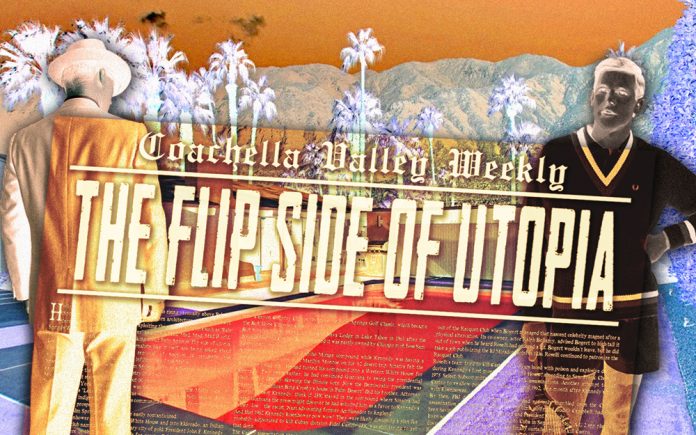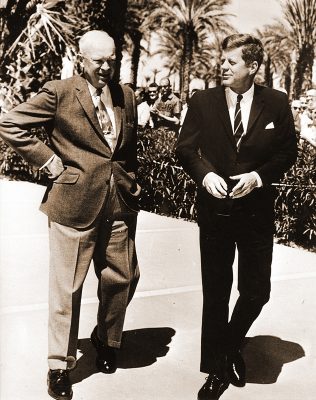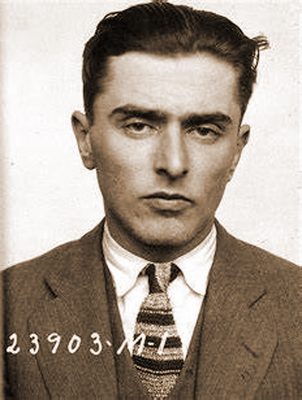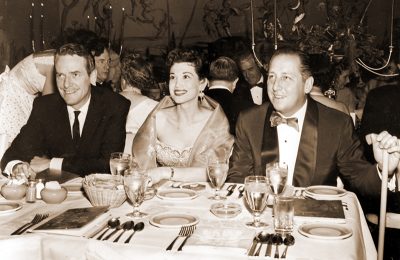
By Bruce Fessier
Hollywood has long found gold in the mountains rising vertically above Palm Springs – and in the city’s mid-century modern architecture and rocky desert terrain.
But today, instead of just exploiting the scenery for films such as “Palm Springs Weekend,” “Diamonds Are Forever” and “It’s A Mad, Mad, Mad, Mad World,” writers and producers are increasingly asking about Palm Springs’ flip side of utopia.
Local historical societies and older journalists like myself are being asked about historical issues such as the city’s removal of Section 14 residents, the misappropriation of Indian land, and the infiltration of the Mafia.
Researchers want to know, when did Palm Springs go from a fantasy world of white exceptionalism to the multi-cultural tapestry it is today?
My answer is, shit started to get real about 60 years ago.
In 1963, as New York capo Joe Valachi was taking the gag off the Mafia code of Omerta and TV’s “Leave It to Beaver” was wrapping its final symbolic season, Palm Springs’ diverse, indigenous, and nefarious communities were rising from the shadows of its beacon of prosperity.
Stories from Palm Springs back then were easily romanticized.

Dwight D. Eisenhower moved out of the White House and into Eldorado, an Indian Wells country club named after the legendary city of gold. President John F. Kennedy visited him there in 1962, sowing the seeds for greater Palm Springs becoming the Playground of the Presidents.
Frank Sinatra produced Kennedy’s 1961 inaugural balls. He made his best albums, filled Nevada showrooms, and started film and recording companies in the early ’60s. His valet, George Jacobs, said stars and show biz leaders moved to Palm Springs just to gain access to him. Sinatra drew more stars to his celebrity golf tournament at the new Canyon Country Club in 1963 than the Palm Springs Golf Classic, which became the Bob Hope Chrysler Classic.
But Sinatra had to relinquish his Cal Neva Lodge in Lake Tahoe in 1963 after the Nevada Gaming Control Board learned it was partly owned by Chicago mob boss Sam Giancana.
Sinatra was stewing at his Rancho Mirage compound while Kennedy was having a rendezvous of his own with Marilyn Monroe on his ’62 desert trip. Sinatra felt the President owed him. He had turned his compound into a Western White House for Kennedy. Two years earlier, he had convinced Giancana to swing the presidential election for JFK by skewing the Illinois vote. Now the Democratic president was staying at Republican Bing Crosby’s house in Palm Desert? Did his brother, Attorney General Robert Kennedy, think if JFK stayed in the compound where Sinatra had hosted Giancana the press might discover he had solicited him as a favor to Kennedy’s father, Joe — the racist, Nazi-advocating former Ambassador to England?
And that 1962 Kennedy-Eisenhower pow-wow? They were likely discussing a plan Ike probably authorized to kill Cuban dictator Fidel Castro. JFK was still trying to get that done.
The Castro assassination theory
The CIA had planned to train 25 Cuban exiles to overthrow Castro in March 1960. When that escalated into an invasion proposal, advisors suggested killing him instead. The CIA contacted Howard Hughes’ chief of Nevada operations, Robert Maheu, who did off-the-book CIA jobs, offering $150,000 to arrange Castro’s assassination.
The man Maheu chose for the job was Chicago mobster Johnny Roselli, whose Palm Springs history went back to 1935. The town’s future mayor, Frank Bogert, threw him out of the Racquet Club when Bogert managed that nascent celebrity magnet after a physical altercation. Its co-owner, actor Ralph Bellamy, advised Bogert to high-tail it out of town when he heard Roselli had ordered a hit. Bogert wouldn’t leave, but he did take a job publicizing the El Mirador Hotel in 1936. Roselli continued to patronize the Racquet Club.

Roselli’s team tried to kill Castro with cigars laced with poison and explosive devices during Kennedy’s first month in the White House, according to Sen. Frank Church’s 1975 Select Subcommittee reports on CIA assassinations. Another attempt to get Castro to swallow poison pills failed in April 1962, one month after Kennedy’s talk with Eisenhower.
By then, FBI director J. Edgar Hoover had not only stumbled upon the Castro assassination plot, he learned Roselli’s one-time girlfriend, Judith Campbell, had also been having sex with Giancana, Sinatra and President Kennedy.
Even so, Roselli sent another hit squad to Cuba in September 1962. A U-2 spy plane’s discovery of Cuban missiles in October finally curtailed plans to kill Castro.
Roselli later described his CIA mission to another girlfriend, singer-actress Betsy Duncan (now Hammes) of Palm Springs.

Duncan, now 91 and due to be interviewed for a documentary on Roselli in January, first encountered Roselli while singing at the Las Vegas El Rancho Hotel. She was being harassed by its owner and Roselli resolved her problem without encountering her, she said. She met Roselli in Los Angeles in the late ’50s, finding him “nice and charming.” They remained friends until 1976, when Roselli’s body was found in a barrel in the Caribbean Sea.
The FBI agent overseeing Palm Springs, Clayton Taylor, said he surveilled Roselli at the now-demolished Canyon Hotel in the ’60s. Duncan said they also shadowed her.
“When I was singing at the El Mirador (in 1961), the FBI was following me the entire time,” she said in October. “I said, ‘Why don’t you speak to me?’ They watched me to see if Johnny Roselli would get in touch with me and he never did.”
After the Castro assassination plot was terminated, Duncan said Roselli told her he took the job out of a sense of patriotic duty. He said he didn’t accept the CIA’s $150,000.
“He said he had three gunboats shot out from underneath him,” Duncan told me. “He said he tried three times.”
Roselli hosted an L.A. wedding party for Duncan and businessman Ever Hammes in 1969. After that, Duncan said Roselli stayed in Palm Springs with Sinatra’s best friend, Oscar-winning composer Jimmy Van Heusen.
Mafia infiltration
Palm Springs was an open town for organized crime even before then. Al and Lou Wertheimer, members of Detroit’s Purple Gang, started the posh Dunes casino in Cathedral City in 1934. Working for him were Irwin Rubinstein, who later owned Sinatra’s favorite Palm Springs post-war supper club, Ruby’s Dunes, and Wilbur Clark, who later fronted the Desert Inn for the Cleveland syndicate. Sinatra made his Las Vegas debut there in 1951.
Dunes pit boss George Zouganelis became a popular Palm Springs bookie when The Dunes and two other Cathedral City casinos were shut down in the early 1940s. Bogert called him, “highly respected by everyone in town.”
Zouganelis and Frank Portnoy, another Dunes employee-turned-casino owner and restaurateur, were charged with bookmaking in 1956 after a raid by 40 deputies. Portnoy pleaded guilty to five counts, but Superior Court Judge Hilton McCabe, who later oversaw a controversial Indian conservatorship program we’ll get to later, gave him probation and a $750 fine. Zouganelis had his charges dismissed for insufficient evidence.
By August 1961, Palm Springs was so infested with mobsters, Robert Kennedy had Taylor open an auxiliary FBI office in Palm Springs, moving him from the FBI’s L.A. organized crime unit.
“What I found was, most of the organized crime figures came here to vacation,” Taylor told me for a 2014 Desert Sun Mafia series. “They stayed mostly at El Mirador Hotel and they would spill over to the Spa and a couple of others. Then they would rent houses for the season.”
Taylor’s first surveillance target was Chicago’s godfather emeritus, Tony Accardo. Taylor only found him when a neighboring insurance adjuster came to his house for dinner.
“We were talking about Tony Accardo,” Taylor recalled, “and he says, ‘I know where he lives.’ So we got in the car and drove to his office. (Accardo) was staying in a house in Canyon Country Club. It had wind damage to the roof.”
Former Palm Springs Police officer Mark Moran, who died in August, grew up with mobsters as neighbors. His father was on the organized crime task force of Riverside County Sheriff Ben Clark. When Moran became a full-time cop in 1973, his dad told him, “Keep your nose clean.”
“The Palm Springs Police Department was one of the most corrupt police departments in the United States,” Moran told me in 2014. “The (county) Law Enforcement Intelligence Unit considered that, if they gave information to the Palm Springs Police Department, it was in the hands of the mob within an hour.”
New York mob bosses selected a private Las Palmas neighborhood home for a 1965 confab with Jerry Zarowitz, a convicted sports fixer who ran Caesars Palace in Las Vegas after developer Jay Sarno launched it in 1966. Sinatra began a residency at Caesars in ’67. In 1972, Zarowitz built a Las Palmas mansion at 911 Juarez Ave., modeled after the Vatican and Emperor Nero-inspired casino. It’s now using Zarowitz’s reputation as “the boss” of Caesars Palace as a selling point.
But ex-Palm Springs Police Chief Lee Weigel, a beat cop in the ’70s, said his force was not corrupt. He acknowledged the Los Angeles Police Department would not share organized crime information with Palm Springs cops but said that changed after Tom Kendra became chief in 1977. He appointed a four-man unit to monitor Chicago mobsters, including Accardo.
“Back in the old days,” said Weigel, “our attitude was, ‘Yeah, there’s organized crime people that live in Palm Springs. But they don’t do business here, so we don’t do anything to them.’ I think that was real bothersome to the LAPD. For years, they wouldn’t let us in the organized crime brotherhood, if you will. We weren’t soft. We had a reputation for being that way, but we certainly didn’t feel we were.”
One reason for their reputation might have been because Sinatra and other local stars performed annual concerts for the Palm Springs Police Officers Association in return for small favors.

The Police Show began in 1949 after ex-vaudevillian Eddie Cantor suggested it to Ray Ryan, a high-stakes gambler who would soon buy a managing interest in the El Mirador.
In 1962, the show featured Sinatra, Hope, Gene Autry, Jayne Mansfield, and Jack Jones, who won a Grammy that year. In 1963, the bill included Dean Martin, Dinah Shore, Red Skelton, Troy Donahue and Connie Stevens.
The latter two were in town shooting the youth culture film, “Palm Springs Weekend,” which helped turn Palm Springs’ spring break tradition into a wild mass exodus. Sinatra often recruited local stars for the Police Show, knowing they could benefit from rides home from cops if they were ever caught drinking and driving.
Weigel didn’t deny a quid pro quo relationship with the stars who performed for free to raise funds for the cops’ pension and other services.
“It was the money that kept our union in business,” he told me before his 2002 retirement. “To think if they were stopped for speeding after they spent a night a year of raising us up to $50,000 to run our police association, to think they wouldn’t get a break would be ludicrous. They would. All the officers that worked here, unless they were on duty, were working the Police Show and these celebrities were talking to everybody.”

The Police Show was one of Palm Springs’ two signature events of 1962 and ’63. The other was Desert Circus, which featured events ranging from hayseed activities to a sophisticated ball. Its parade down Palm Canyon Drive included horseback riders, marching bands and floats featuring major stars and folks from the Mexican Colony, as the Latinx from Section 14 of the downtown Indian Reservation called themselves. Other minorities didn’t have a float, although local nightclubs prominently featured Black and Hispanic entertainers.
Wertheimer started Desert Circus in 1934, the same year he opened the Dunes casino. Ryan, a frequent Desert Circus “high sheriff,” recruited Wilbur Clark for that role in ’61. He judged a costume contest with Bogert and followed L.A.’s real sheriff, Peter Pitchess, in the parade.
Hollywood gossip columnist Louella Parson was the 1962 Desert Circus Queen. She reigned over a Desert Circus Ball featuring music by Grammy-winning singer Keely Smith, who had been romantically linked to Sinatra and Giancana. California Gov. Pat Brown attended with Democratic political operative Phil Regan, who was convicted of bribing a public servant in 1972. Ryan hosted a table with actors William Holden and Bruce Cabot, the Duke and Duchess of Manchester, England, and the ubiquitous Bogert.

Roberta Linn, who, at 94, still performs weekly at T’s on the Green in Cathedral City, is probably the last star to have appeared in the Police Show and Desert Circus. She was Lawrence Welk’s first TV “champagne lady” and performed at mob-owned venues across the nation. She met Maheu in the Sahara Hotel lounge in Las Vegas with her mother.
“I had a low-cut dress on and this man kept circling the tables,” she recalled. “He gave me his card and it was Mr. Maheu. He said, ‘Mr. Hughes would like to invite you to dinner tomorrow night.’ My mother said, ‘She’s not going to dinner with Mr. Hughes.’”
Ryan was her bridge between Vegas and Palm Springs in the late ’50s.
“Ray flew two Western Airlines planes from here with all the big stars on them and supplied all the rooms and all the food and all the booze and gave everybody money to gamble with,” she said. “We stayed at the Sands. Jakey Freedman (a frontman for New York mob bosses Meyer Lansky and Frank Costello) was the Jewish connection to the Sands. I loved him.
“We were a family. We were owned by the mob. Our contracts came through these fellows that ran the hotels. And those were the best years. They were wonderful hosts.”
Linn ended her relationship with Ray in 1959. In 1961, she married a rock and roller, Freddie Bell of the Bellboys, who inspired Elvis Presley’s version of “Hound Dog.”
Ryan was called “Mr. Palm Springs” in those “Leave It to Beaver” years. But the times they were a-changing. Ryan became a marked man in 1963. A gangster found his mark in 1977 in Evansville, Indiana.
Read part two of “The Flip Side of Utopia” at CoachellaValleyWeekly.com/the-flip-side-of-utopia-part-2.
Bruce Fessier is a veteran Rancho Mirage-based journalist. Contact him at jbfess@gmail.com, facebook.com/bruce.fessier, instagram.com/bfessier or twitter.com/BruceFessier.










































